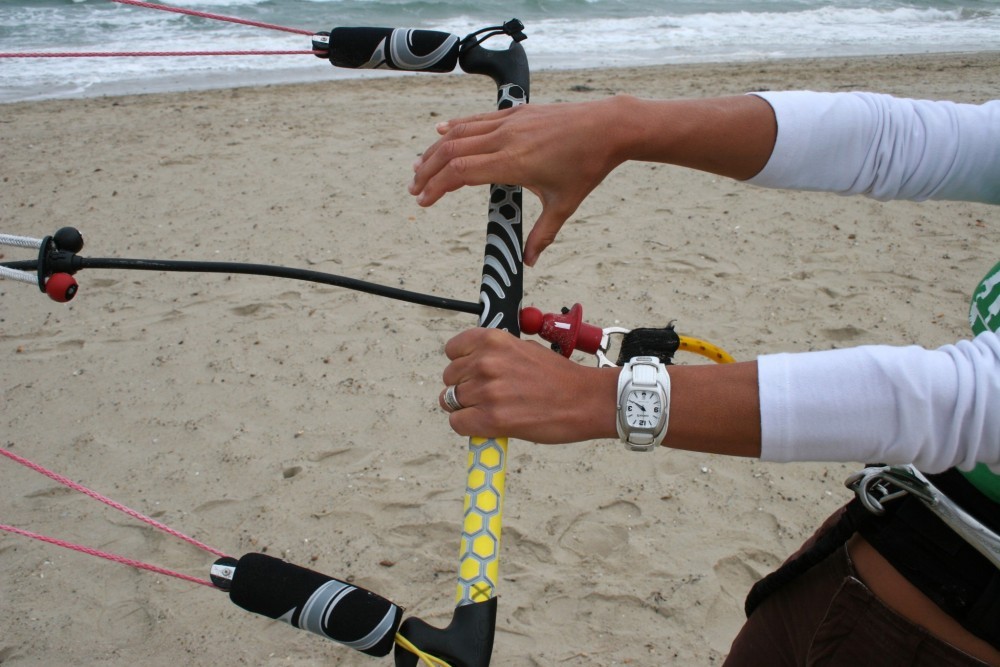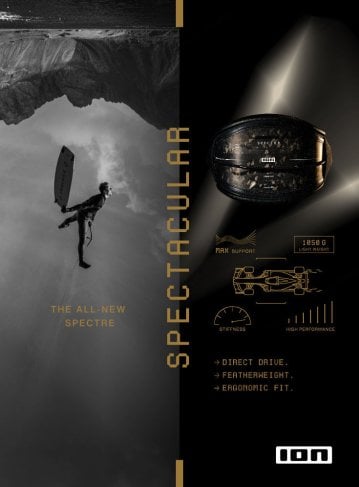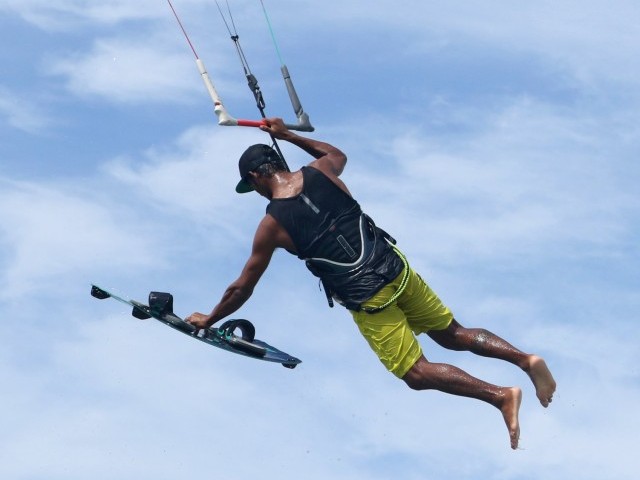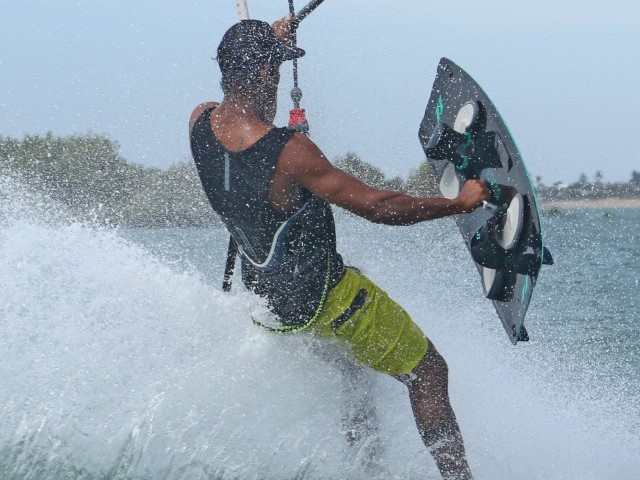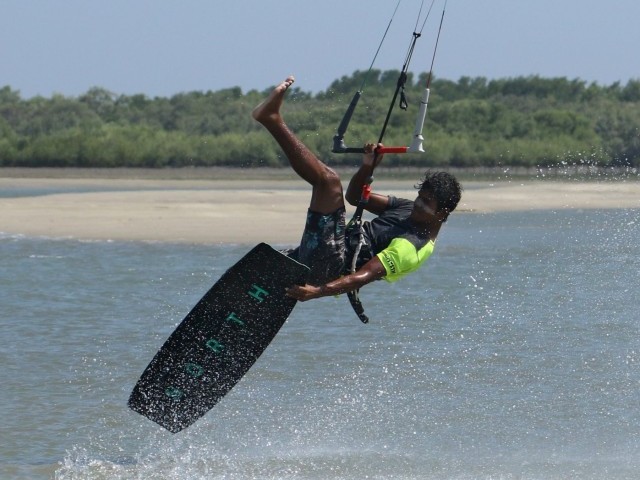
Down Loop S-Bend
Technique / Advanced
Introduction
We’re throwing this in just in time for those winter gusts and/or trips abroad. We’ve noticed quite a bit of down looping this summer, and this is a fairly simple add-on. In itself the move opens up a plethora of possibilities, done super powered up it can deliver some seriously arching height, looks great off a wave and is a real crowd pleaser when thrown to blind.
Not wishing to state the obvious (but we will), it’s more than a fine idea to be happily pulling unhooked tricks such as raleys, down-loops, f16s and to be honest the ability to s-bend wouldn’t hurt either. The chances are that you will be landing with speed and a looping kite, so you’ll need a lot of space for sticking it and crashing it. If the wind has any onshore make sure you’re far, far out, as the last thing you’ll need is a broken kite or injured beach goer. Also respect those other kiters; it’s no fun crashing because you’re trying to avoid some fruit loop charging downwind with a hyperactive kite doing mach 10.… Deep water is also good. Needless to say bow-like depower or a 5th line are a must for the more abortive attempts.
The Down Loop
The kite down loops when it is sent with the direction of travel by being somewhat aggressive on the front hand’s side of the bar. It is best to start with the kite at 12 o’clock. This will give you more lift, more time to react, and more chance of landing. To loop the kite you’ll need to adopt an over-under pole grip on the leading side of the bar. To do this once you have unhooked, with your hands centred on the bar, you will release your back hand, reach underneath your front hand and grab the bar with your palm facing up (see pics A and B).
The S-bend
An s-bend is the most effective way of completing a pop forward rotation when powered. The primary difference between this and a standard front loop is the take off. When learning the front loop we usually throw our head and front shoulder down towards the water, bending and folding in the process, as if we were roley-poleying. Because we have sent the kite, it gives us the necessary lift. To complete an s-bend, when we are using pop rather than the kite, we extend our spine by lifting our trailing shoulder and looking back. As we are not throwing ourselves down at the water, but actually extending upwards we produce a bit of extra height, which in turn enables us to rotate further and more quickly, landing slightly off the wind with our feet and board underneath us. If you try popping a front loop type of rotation with the kite low, you invariably land hard on the crown jewels with the board in front of you. Not a good option.
The Full Monty
Like many moves your first attempts at this are best when you’re not clinging onto your bar for dear life. Larger kites will give more lift and time, smaller kites will turn more quickly, so middle of the road relative to your weight would be ideal. The key to down looping is timing, more precisely going early.
The approach needs to be controlled so that you can pre-empt what is about to happen. Think back to learning the down loop and reminisce how the kite would loop whilst you just got pulled off down wind. If your kite is so quick that it’s already completed a loop and you haven’t had time to say “crikey”, try something slower. If you are not getting much lift from your down-loops, keep practicing them following the sequences here, but forget the s-bend.
Following Sequence A
- Having checked that the coast is clear Karine has slowly moved the kite up towards 12 o’clock, standing up slightly, releasing her edge to unhook more easily and get the kite above her.
- She crosses her back hand underneath onto the front of the bar.
- And carves hard off the back foot whilst dropping her weight to keep her edge and turn upwind, away from the kite.
This all happens very quickly and is the preparation of popping up before the kite pulls too hard. The longer you take the further the kite will have moved, making it harder to complete the move before the kite starts a second rotation.
- As she carves the kite has started to move forward. In anticipation Karine has compressed her legs ready to launch. She is not waiting to get ripped off the water by the kite, but instead will explode upwards as soon as she feels the kite begin to pull. Up to this stage she could also be going for a straight down-loop. (The only difference being that as she jumps she will look over her hands towards the kite for balance and prepare for a downwind landing).
- As the kite starts to pull she stamps down on the back leg and throws herself upwards, literally jumping into the air.
- To initiate the rotation she has thrown her trailing (right) shoulder up.
- The kite is now generating a fair amount of pull as it turns, good top to toe stretch. This is real commitment time, just hold on and enjoy the flight.
- The kite continues it’s journey and the yank will in fact pull Karine around the rest of her rotation.
- Karine’s only effort is to twist her head and search for the landing strip.
- Once she sees the water the rest of the body follows suit, the completion of the s-bend bringing her feet back underneath. If at this stage you feel you still have some height, its time to let go with the original back hand (right) to help slow your rotation and balance the landing.
- On touch down Karine absorbs the impact with soft knees, and once they have recovered she grabs the bar again with the back hand, sails on down wind to hook back in and giggles ecstatically.
What’s Happening?
In a perfect world, as you land you will see your kite once again diving down towards the sea. Which means that you can grab the back of the bar and pull the kite out of its dive as you hook in.
It’s not uncommon that the kite is further around another loop than you would hope. If this is the case follow it out toe side and transform the whole shindig into a lovely transition.
There are two reasons for the kite doing this:
- Firstly if you edge for your country and wait for the kite to physically rip you off the water the kite will almost have finished a complete loop before you get airborne. To correct this, just think about going early. By this we mean swap you hands, carve and jump up. You should then get the pull in the air, a slower rotation, more height and a sweeter landing.
- Secondly you’re on a tiny kite.
For obvious reasons if it’s howling and you are on a small kite, this is unavoidable. If you still go early you should be able to enjoy the second loop as you drop your undercarriage for landing. Good luck to you.
Top Tips
If you are having trouble finishing your rotation, try starting with the kite higher. It’s fairly unnatural to stick the kite at 12 o’clock.
Once you’re confident try using more power. That is to say don’t pull the trim strap as far down as you usually would for an unhooked move.
Bowsexuals should eventually be doing this without pulling on any trim. In fact we actually let the trim off to move the bar further away from us than we would normally ride for kite loops!
Both of the above will result in it being harder to unhook, so head downwind a tad more to release the tension in your chicken loop.
More power in the kite should give you a slower rotation, but a more fearsome, guns blazing downwind yank. Marvellous.
This technique article was in Issue 1 of IKSURFMAG.
Related
By Christian and Karine
Christian and Karine have been working together as a coaching team, running improver to advanced kitesurfing clinics since 2003.







